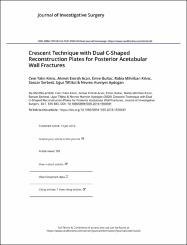| dc.contributor.author | Kılınç, Cem Yalin | |
| dc.contributor.author | Açan, Ahmet Emrah | |
| dc.contributor.author | Gültaç, Emre | |
| dc.contributor.author | Kılınç, Rabia Mihriban | |
| dc.contributor.author | Serbest, Sancar | |
| dc.contributor.author | Tiftikçi, Uğur | |
| dc.contributor.author | Aydoğan, Nevres Hürriyet | |
| dc.date.accessioned | 2020-11-20T14:30:08Z | |
| dc.date.available | 2020-11-20T14:30:08Z | |
| dc.date.issued | 2020 | |
| dc.identifier.issn | 0894-1939 | |
| dc.identifier.issn | 1521-0553 | |
| dc.identifier.uri | https://doi.org/10.1080/08941939.2018.1550541 | |
| dc.identifier.uri | https://hdl.handle.net/20.500.12809/372 | |
| dc.description | 0000-0003-2696-8303 | en_US |
| dc.description | WOS: 000571509200016 | en_US |
| dc.description | PubMed ID: 30644789 | en_US |
| dc.description.abstract | Background:Here we have defined a novel technique for repairing posterior acetabular wall fractures called the "crescent technique," in which dual C-shaped reconstruction plates overlap at the distal ends and, if necessary, at the proximal ends. We also analyzed the efficacy and reliability of this method.Patients and Methods:This was a retrospective analysis of 27 patients undergoing the crescent technique. All of the fractures were treated by the senior author for a mean of 7.9 days (0-15 days) after the trauma. The mean follow-up period was 19 months (13-29 months). The clinical results were evaluated using the modified clinical grading system developed by Merle d'Aubigne and Postel, and then modified by Matta. The radiographs were graded according to the criteria described by Matta.Results:In the clinical grading, 16 (59%) of the patients were excellent and very good, 5 (19%) were good, 3 (11%) were moderate, and 3 (11%) were poor. According to the Matta radiological evaluation criteria, 19 (70%) were excellent, 4 (15%) were good, 4 (15%) were fair, and none were poor. Statistically significant consistency was seen between the clinical and radiological results (p = 0.002).Conclusions:The crescent technique is a dual plate technique modification that can provide a stable fixation. It appears to be an effective and reliable method for treating posterior wall fractures of the acetabulum. | en_US |
| dc.item-language.iso | eng | en_US |
| dc.publisher | Taylor & Francis Inc | en_US |
| dc.item-rights | info:eu-repo/semantics/openAccess | en_US |
| dc.subject | Acetabulum | en_US |
| dc.subject | Dual Plate | en_US |
| dc.subject | Fracture | en_US |
| dc.subject | Posterior Wall | en_US |
| dc.title | Crescent Technique with Dual C-Shaped Reconstruction Plates for Posterior Acetabular Wall Fractures | en_US |
| dc.item-type | article | en_US |
| dc.contributor.department | MÜ, Tıp Fakültesi, Cerrahi Tıp Bilimleri Bölümü | en_US |
| dc.contributor.institutionauthor | Kılınç, Cem Yalin | |
| dc.contributor.institutionauthor | Gültaç, Emre | |
| dc.contributor.institutionauthor | Kılınç, Rabia Mihriban | |
| dc.identifier.doi | 10.1080/08941939.2018.1550541 | |
| dc.identifier.volume | 33 | en_US |
| dc.identifier.issue | 7 | en_US |
| dc.identifier.startpage | 675 | en_US |
| dc.identifier.endpage | 683 | en_US |
| dc.relation.journal | Journal of Investigative Surgery | en_US |
| dc.relation.publicationcategory | Makale - Uluslararası Hakemli Dergi - Kurum Öğretim Elemanı | en_US |


















